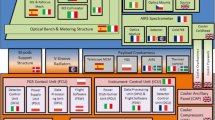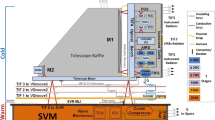Abstract
The Atmospheric Remote-sensing Infrared Exoplanet Large-survey mission (ARIEL) (Tinetti et al. 2017) is one of the three present candidates for the ESA M4 (the fourth medium mission) launch opportunity. The proposed Payload (Eccleston et al. 2017; Morgante et al. 2017; Da Deppo et al. 2017) will perform a large unbiased spectroscopic survey from space concerning the nature of exoplanets atmospheres and their interiors to determine the key factors affecting the formation and evolution of planetary systems. ARIEL will observe a large number (> 500) of warm and hot transiting gas giants, Neptunes and super-Earths around a wide range of host star types, targeting planets hotter than 600 K to take advantage of their well-mixed atmospheres. It will exploit primary and secondary transits spectroscopy in the 1.2 − 8μ m spectral range and broad-band photometry in the optical and Near IR (NIR). The main instrument of the ARIEL Payload is the IR Spectrometer (AIRS) (Amiaux et al. 2017) providing low-resolution spectroscopy in two IR channels: C h a n n e l 0 (C H 0) for the 1.95 − 3.90μ m band and C h a n n e l 1 (C H 1) for the 3.90 − 7.80μ m range. It is located at the intermediate focal plane of the telescope (Da Deppo et al. 2016, 2017, 2017) and common optical system and it hosts two IR sensors and two cold front-end electronics (CFEE) for detectors readout, a well defined process calibrated for the selected target brightness and driven by the Payload’s Instrument Control Unit (ICU).
















Similar content being viewed by others
Notes
System Image, Digitizing, Enhancing, Controlling, And Retrieving.
A single DCU per channel is foreseen.
The mean or χ 2 of the data is computed; deglitching by rejecting samples having a value above a threshold is an option (though not implemented currently).
TCU included, Decontamination Mode excluded.
Indeed, the DCU SpW I/F link could be replaced with a common and simpler serial I/F, but the former offers the possibility to the CPU to read from and write to directly to the DCU FPGA registers, for remote configuration, thanks to the RMAP protocol.
The UT699E LEON3FT UART port is not compatible with the UART/RS485 hosted by the DCU FPGA as it isn’t able to manage the enabling/disabling of the transmission driver as required by the standard RS485 when adopting a single TX/RX line. For this reason, the RS485 bus, is used to interface the DCU FPGA by means of the Data Processing Unit FPGA.
Hardware Description Language.
Some more bit, beside 16, are needed to represent the quality criteria of the ramps slopes and fitting. AIRS adopts additional 8 bit for the ramp quality criteria definition.
It is also foreseen, as baseline, an external signal for synchronization (with TBD frequency, amplitude and overall characteristics) in case the SpW packets time stamping exploiting Time Codes and an internal HW clock were not able to guarantee the needed timing accuracy for scientific data processed and sent to the S/C in quasi real-time.
Bi-level Switch Monitor.
In order to implement only a high-level SW (ASW) running on the ICU processor (hosted by DPU) in charge of Instrument management, data processing (TBD) and FDIR procedures, this complex solution should be avoided.
A spaxel is a set of binned pixels in both spatial and spectral dimensions.
References
Tinetti, G., et al.: A chemical survey of exoplanets with ARIEL (2017)
Eccleston, P., et al.: The ARIEL payload, Special Issue on ARIEL, Experimental Astronomy (2017)
Morgante, G., et al.: The thermal architecture of the ARIEL payload module: design and predictions, Special Issue on ARIEL, Experimental Astronomy (2017)
Da Deppo, V., et al.: The Telescope for the ARIEL ESA M4 mission proposal: design and performance, Special Issue on ARIEL, Experimental Astronomy (2017)
Amiaux, J., et al.: AIRS, the ARIEL spectrometer, Special Issue on ARIEL, Experimental Astronomy (2017)
Da Deppo, V., et al.: An afocal telescope configuration for the ESA ARIEL mission. In: ICSO international conference on space optics Biarritz (FR) (2016)
Da Deppo, V., et al.: The Afocal telescope optical design and tolerance analysis for the ESA ARIEL mission. OSA Optical Design and Fabrication Congress, Denver (2017)
Da Deppo, V., et al.: An afocal telescope configuration for the ESA ARIEL mission. CEAS Aeronaut. J. (2017)
Rataj, M., et al.: The fine guidance system (FGS) of the ARIEL payload, Special Issue on ARIEL, Experimental Astronomy (2017)
Chen, J., et al.: SIDECAR ASIC firmware for astronomy applications. SPIE Proc. 9154, 915426 (2014)
Corcione, L., et al.: The data processing unit of the NISP instrument of the Euclid mission. SPIE Proc. 9143, 914331 (2014)
Sierra-Roig, C., et al.: The ARIEL ESA mission on-board metrology. In: Proceedings of the 4th IEEE international workshop on metrology for Aerospace Padova (IT) (2017)
Farina, M., et al.: Ariel spectrometer instrument control and data processing software. European planetary science congress (EPSC), Riga (2017)
Acknowledgements
The authors gratefully acknowledge the UKSA/SFTC, the European Research Council (ERC) for the founded project ExoLights (617119), the Italian Space Agency for the financial contribution to the ARIEL project in the framework of the ASI-INAF agreement 2015-038-R.0 and the Spanish Ministry of Economy and Competitiveness (MINECO) for the support through grants ESP2014-57495C2-2-R and ESP2016-80435-C2-1-R. Many thanks also to CGS/OHB Italy for the help to the DCU board design.
Finally, a special thank to the European Space Agency for the support provided by the ARIEL Study Team.
Author information
Authors and Affiliations
Corresponding author
Rights and permissions
About this article
Cite this article
Focardi, M., Pace, E., Farina, M. et al. The ARIEL Instrument Control Unit design. Exp Astron 46, 1–30 (2018). https://doi.org/10.1007/s10686-017-9560-3
Received:
Accepted:
Published:
Issue Date:
DOI: https://doi.org/10.1007/s10686-017-9560-3




